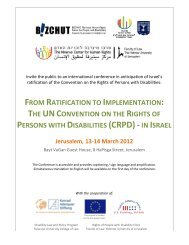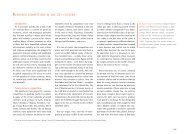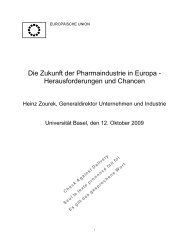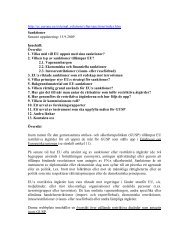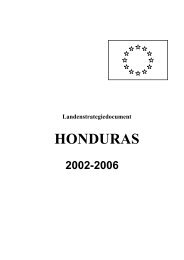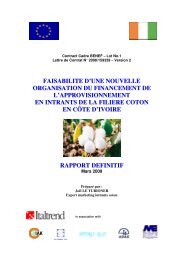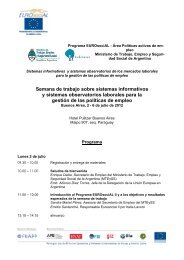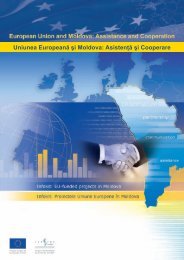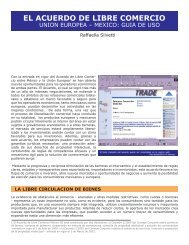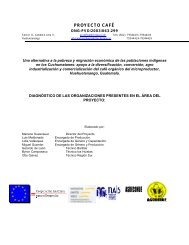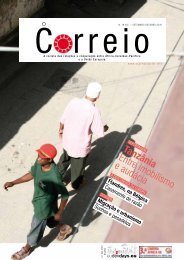Regional Reports - the European External Action Service
Regional Reports - the European External Action Service
Regional Reports - the European External Action Service
Create successful ePaper yourself
Turn your PDF publications into a flip-book with our unique Google optimized e-Paper software.
2.2. Distribution of NSA in ANRS<br />
The distribution pattern varies according to <strong>the</strong> typologies. Most of <strong>the</strong> international NGOs and<br />
FBOs are concentrated in <strong>the</strong> drought prone and food insecure zones of <strong>the</strong> region. Table 4<br />
presents <strong>the</strong> zonal distributions of NGOs and <strong>the</strong>ir projects within Amhara. North Shoa, which is<br />
<strong>the</strong> closest to Addis Ababa and also <strong>the</strong> drought prone zone, has <strong>the</strong> highest rank both in number<br />
of operational NGOs and <strong>the</strong>ir programmes and projects. It appears that a number of national<br />
NGOs have opted to roll-out <strong>the</strong>ir programmes out of Addis Ababa to this zone as <strong>the</strong> logistical<br />
requirements are relatively affordable or manageable.<br />
Table 4. Zonal Distributions of ongoing NGO projects in ANRS<br />
S/No Administrative Zone<br />
No of<br />
NGO's<br />
No of ongoing<br />
Projects<br />
% of<br />
Projects<br />
1 North Shoa 34 61 19<br />
2 South Wollo 30 51 16<br />
3 North Gonder 24 29 9<br />
4 North Wollo 22 45 14<br />
5 Bahir Dar 22 31 10<br />
6 South Gonder 16 38 12<br />
7 Region 11 15 5<br />
8 West Gojjam 10 14 4<br />
9 East Gojjam 11 16 5<br />
10 Waghemra 6 9 3<br />
11 Oromia 4 4 1<br />
12 Awi 4 4 1<br />
Total 317<br />
Source based on data from <strong>the</strong> <strong>Regional</strong> FS&DPPO<br />
To a large extent <strong>the</strong> NSA landscape is dominated by institutions that have urban-based origin<br />
and focus. This situation is expected and unavoidable. For example, <strong>the</strong> HIV/AIDS pandemic had<br />
<strong>the</strong> greater impact so far on <strong>the</strong> urban population; hence most of <strong>the</strong> anti-AIDS clubs and<br />
Reproductive Health Associations are of urban origin and focus.<br />
In <strong>the</strong> rural areas cooperatives and local branches of <strong>the</strong> region-wide membership-based<br />
associations are omnipresent. According to <strong>the</strong> Cooperative Promotion Agency, about 1.88<br />
million people (which is about 64% of <strong>the</strong> rural house-holds) are members of <strong>the</strong> various<br />
agricultural cooperatives. At local level, particularly <strong>the</strong> region-wide membership-based<br />
associations are invisible, due partly to capacity and positioning. In Gubalafto Woreda of North<br />
Wollo, <strong>the</strong> Secretary of <strong>the</strong> Woreda Women's association is sharing <strong>the</strong> office space and<br />
operational budget of <strong>the</strong> Woreda Women's Affairs' Office. On <strong>the</strong> o<strong>the</strong>r hand, apart from ORDA,<br />
it has no operational partnership and linkage with o<strong>the</strong>r NGOs and FBOs operating in <strong>the</strong><br />
Woreda.<br />
In summary, <strong>the</strong> current distribution of NSA is biased and in favour of urban and drought prone<br />
parts of <strong>the</strong> region. Perhaps more coordinated effort is needed to ensure that more and more NSA<br />
focused to <strong>the</strong> rural and agricultural innovation and intensification fields are brought to <strong>the</strong><br />
picture.<br />
111




